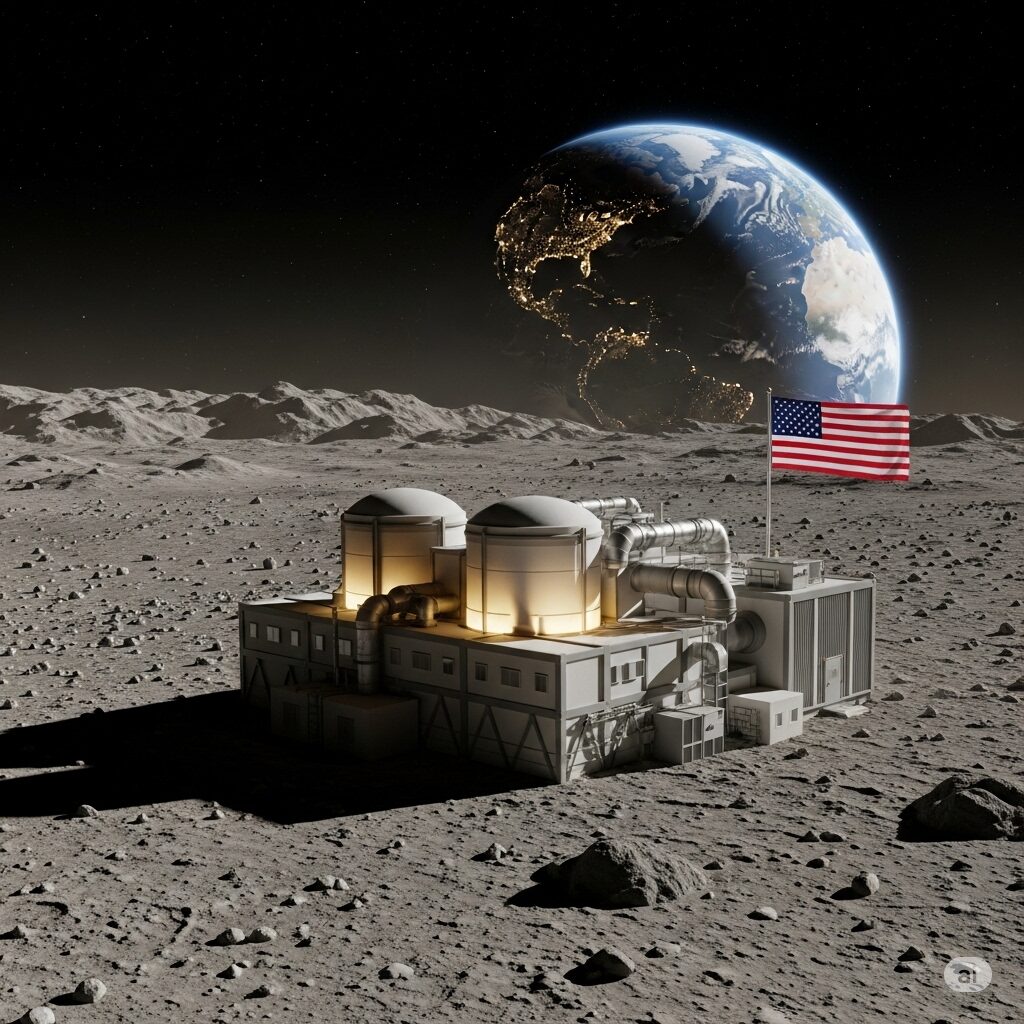The Lunar Power Play: Why America is Racing to Build a Nuclear Reactor on the Moon

For decades, space exploration has been about flags and footprints. But as humanity looks beyond fleeting visits to establishing permanent outposts, a new, critical race has emerged: the strategic infrastructure race. At its heart? Nuclear power.
The United States, through NASA, is accelerating plans to construct a 100-kilowatt nuclear reactor on the Moon by 2030. This ambitious goal is not just about advancing technology; it’s a bold move to secure America’s leadership in the burgeoning lunar economy and future deep-space missions.
Why Nuclear Power is Essential for Space
While solar panels have long been the workhorse of space missions, they face significant limitations, especially for long-term lunar and Martian habitation:
- Lunar Darkness and Craters: The Moon experiences 14-day stretches of darkness. Crucially, some scientifically vital craters, believed to contain water ice (a critical resource), never receive sunlight. Solar power is simply unreliable, if not impossible, in these areas without massive, heavy battery storage.
- Martian Challenges: On Mars, dust storms can last for weeks or months, severely impacting solar power generation and even leading to mission failure, as seen with the Opportunity rover.
- Distance from the Sun: The farther a spacecraft travels from the Sun, the less effective solar power becomes. For example, the New Horizons probe had only 200 watts of power when it flew past Pluto, which limited its ability to enter orbit or stream data in real-time.
Nuclear power offers a game-changing solution due to its high energy density and ability to provide continuous, abundant power. A “softball-sized chunk of Uranium-235, when fully fissioned, offers as much energy as a freight train full of coal”. This transformative power boost is likened to the shift from candlelight to grid electricity on Earth, enabling “industrial-scale work” like 3D printing and mining operations, which require hundreds of kilowatts of power that solar cannot provide. It’s seen as the “linchpin for long-term human activity” and the “foundation for opening the solar system”.
The New Lunar Race: Infrastructure is Influence
The idea of nuclear power in space isn’t new; the U.S. and Soviet Union have used radioisotope generators since the 1960s. However, the current push is driven by a new space race, with China reportedly planning to build a nuclear power plant on the Moon by 2035 to support its international lunar research station. The U.S. response, aiming for a 2030 operational reactor, has “galvanized officials”.
This isn’t an arms race, but a “strategic infrastructure race” where “infrastructure is influence”. Being the first to deploy a reactor on the Moon could “shape the norms for expectations, behaviors and legal interpretations” related to lunar presence. While international law prohibits territorial claims on the Moon, establishing a reactor “establishes a country’s presence in a given area”.
This could lead to the establishment of a “keep-out zone” around the reactor for safety and security reasons, such as radiation risks or accident protocols. Such a zone, justified under the Outer Space Treaty’s Article IX to prevent “harmful interference,” could functionally limit access to resource-rich areas like the lunar South Pole, effectively cementing one country’s access to resources and potentially excluding others.
Hurdles on the Path to Lunar Power
Despite the ambitious timeline and clear benefits, deploying a nuclear reactor on the Moon presents significant challenges:
- Technical Complexities: While the underlying technology exists, the timeline is “racy”. Engineers must contend with unique lunar conditions:
- Lunar gravity affects fluid dynamics and heat transfer.
- The sticky, electrostatic lunar regolith (dust and rocks) can interfere with components like radiators.
- New cooling methods are needed as there is no atmosphere for convection cooling.
- The reactor’s radiator alone would be the size of a basketball court when unfolded, making deployment complex.
- Mass and Delivery: A 100-kilowatt reactor is estimated to weigh between 10 to 15 metric tons. Current commercial rockets generally cannot carry such a load. The plan heavily relies on the readiness of heavy-class landers like SpaceX’s Starship, which has faced test flight failures. Delivering components over multiple launches and landings, along with autonomous assembly, adds further complexity.
- Safety and Regulation: All nuclear technologies demand strict safety restrictions, particularly for launch on rockets and landing in alien environments. The deployment will be subject to high regulatory standards. The U.N. guidelines from 1992, while nonbinding, provide a framework for safety, transparency, and international consultation.
- Budgetary and Workforce Challenges (U.S.): NASA faces significant internal hurdles that could impact its ability to meet the 2030 deadline. The Trump administration has called for a 24% cut year-over-year to NASA’s operating allowance, which would result in the smallest operating budget since 1961. Approximately 4,000 NASA employees (about 15% of its 2023 workforce), including over 2,000 senior staff with specialized skills, have agreed to leave through early retirement or voluntary separation. This “brain drain” and loss of institutional knowledge could severely impact the agency’s ability to execute complex projects like the lunar reactor on time. The estimated annual cost for the lunar reactor project is $800 million for five years.
Despite these challenges, experts believe the goal is achievable, especially with renewed political incentives and growing private sector interest in space nuclear power. Developing this capability on the Moon is also a crucial step before deploying it on Mars, where NASA has already selected nuclear power as the primary surface power generation technology for crewed missions.
Ultimately, the future of the Moon and beyond will be shaped not just by who gets there first, but by who builds what, and how. Establishing a nuclear reactor on the Moon is a monumental step towards permanent human presence and “opening the solar system”.
Sources:
- “A Mob of Alien Creatures Just Took 4 Nuclear Reactors Completely Offline”: Not directly used for lunar/space applications content, but part of the provided source set.
- “Analysis: Why NASA is planning to build a nuclear reactor on the Moon and what the law says | PBS News”: (Source Link:
https://www.pbs.org/newshour/science/analysis-why-nasa-is-planning-to-build-a-nuclear-reactor-on-the-moon-and-what-the-law-says) - “Lunar Nuclear Race: Powering Humanity’s Space Future”: (Source Link:
https://www.wired.com/story/why-nasa-is-racing-to-build-a-nuclear-reactor-on-the-moon/) – Note: The specific article link provided in the source does not directly match the article title ‘Lunar Nuclear Race: Powering Humanity’s Space Future’ but is titled ‘Why the US Is Racing to Build a Nuclear Reactor on the Moon’ with the wired.com domain. - “NASA’s Nuclear Ambition and Budgetary Bind”: (Source Link:
https://www.engadget.com/nasa-nuclear-ambition-and-budgetary-bind-150000305.html) - “NUCLEAR 101: How Does a Nuclear Reactor Work? | Department of Energy”: (Source Link:
https://www.energy.gov/ne/articles/nuclear-101-how-does-nuclear-reactor-work) – Note: This source provides general information on how nuclear reactors work but does not specifically discuss lunar/space applications.




